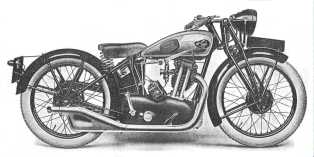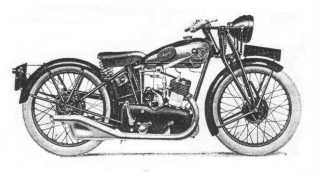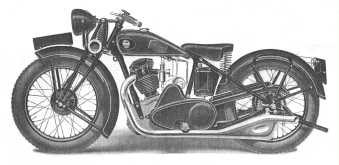
1931 Model NM showing the extensive lining
applied with a colour option |
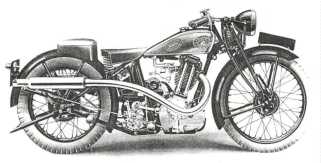
1932 Model CD |
|
For 1931 Triumph had a whole new range of 'Inclined'-engined
machines. Triumph were late in joining the fashion, which had probably
been started by BSA with their 'slopers', but Triumph's cylinders
were 'inclined'!
Not only the 'sloper fashion' but Triumph also incorporated the
other current fashion of partial engine enclosure, and even went
'overboard' with the 'clean lines' by minimising untidy cables. This
was achieved by routing cables within the handlebars until they exited
at the frame headstock, to be routed unseen under the petrol tank or
discretely down a fork leg.
(It had been common practice for many years to
exclude cables from advertisement pictures due to them giving an
untidy appearance to the machine.)
Not only were the cables hidden as much as possible but so also
were oil pipes, for the new inclined engines had the oil reservoir
housed within the crankcase and a quite complex rotating-piston pump
simply transferred
oil between the reservoir and the crankcase proper, and back again; a
distance of maybe an inch.
Initially there were four new models in this range, with a
fifth added shortly after the sales catalogue was produced.
The C-Series Models CN, CSD and CTT continued into 1931 along with the
2-stroke Model X and the Model NSD, which had been the forerunner of
the inclined-engined machines. This brought Triumph's 1931 selection to
a total of ten different models.
In the following years Sports versions were added to the standard
road-going models.
|
Brief Specifications and Variations
The five new inclined-engined models for 1931 were;
Model WO. 249cc ohv. 63mm bore X 80mm stroke.
................... This was Triumph's first 250cc design.
Model WA. 249cc ohv. 63mm bore X 80mm stroke.
................... Later in 1931. A cheaper single-port verson
of the Model WO.
Model WL. 348cc s/v. 72mm bore X 85.5mm stroke.
................... A popular side-valve size.
Model NM. 343cc ohv. 70mm bore X 89mm stroke.
Model NT. 493cc ohv. 84mm bore X 89mm stroke.
All had 3-speed gearboxes, but 4-speed boxes were available as an
optional extra on the Models NM and NT, and also on the other models
from 1932.
The Model NT would have been capable of taking a sidecar, but the
Models CSD and ND had been kept in the range as the workhorses for
that task.
1932 saw the introduction of Sports versions of the Models NM
and NT in the form of the Models CA and CD, respectively, while a
Sports version of the Model WO appeared for 1933, designated the Model
WP.
For 1931 and 1932 optional, no charge, colours were available.
This was an overall colour scheme and was possible at no charge for
the petrol tank no longer needed to be plated! The optional colours
were Red (closer to a maroon), Blue (described as 'electric blue', and
therefore unlikely to have been the Standard Triumph blue), Green and
Grey.
Considering that the world was still in rescession following the 1929
Wall Street Crash in America these inclined-engined models proved to
be popular, but obviously not made in great numbers due to the
general shortage of money.
According to my researches to date, approximately 1,100 Models WO
were made, and approximately 950 of the single-port Models WA.
I have
no knowledge of any surviving Sports Models WP, and it's no use
converting your Model WO or WA to make it look like one, for the
specially tuned engine had a different serial number series! (A Model WP
engine, only, turned up in South Australia in June 2012.)
More general ride-to-work Models WL were made, although catalogued
for a year less than those above; approximately 1,600
Only around 600 Models NM appear to have been made, with Models NT
selling much better at between 1,500 and 2,000.
The Sports Models CA and CD naturally sold less, with between 300
and 400 for the former and around 1,000 for the latter.
The have knowledge of these models, or parts thereof, surviving in Argentina,
Australia, Austria, Belgium, Britain, Czech Republic, Denmark, Estonia,
France, Germany, Holland, Italy, New Zealand, Norway, Portugal,
South Africa, Sweden and the USA.
For more information you really need to read the booklet
I have written on these models.
|
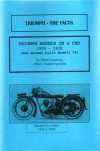
Booklets
|
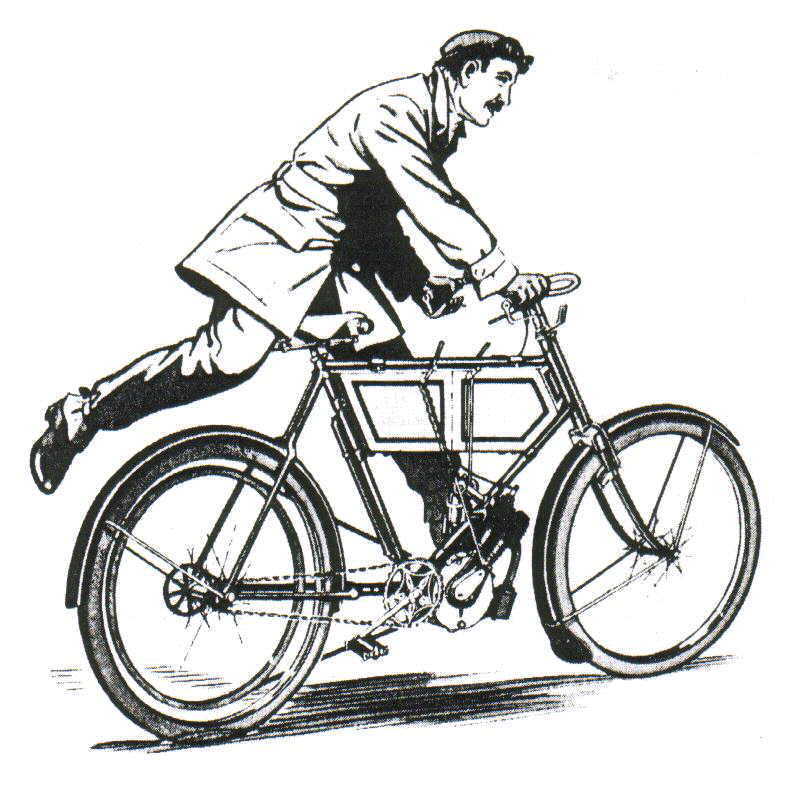
Jump Back to
the Beginning
|

Return to the
Post-Vintage Index
|
|
